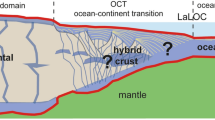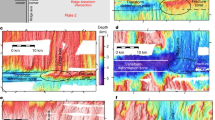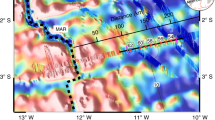Abstract
Pluto is thought to possess a present-day ocean beneath a thick ice shell. It has generally been assumed that Pluto accreted from cold material and then later developed its ocean due to warming from radioactive decay; in this ‘cold start’ scenario, the ice shell would have experienced early compression and more recent extension. Here we compare thermal model simulations with geological observations from the New Horizons mission to suggest that Pluto was instead relatively hot when it formed, with an early subsurface ocean. Such a ‘hot start’ Pluto produces an early, rapid phase of extension, followed by a more prolonged extensional phase, which totals ~0.5% linear strain over the last 3.5 Gyr. The amount of second-phase extension is consistent with that inferred from extensional faults on Pluto; we suggest that an enigmatic ridge–trough system recently identified on Pluto is indicative of early extensional tectonics. A hot initial start can be achieved with the gravitational energy released during accretion if the final stage of Pluto’s accretion is rapid (<30 kyr). A fast final stage of growth is in agreement with models of the formation of Kuiper belt objects via gravitational collapse followed by pebble accretion, and implies that early oceans may have been common in the interiors of large Kuiper belt objects.
This is a preview of subscription content, access via your institution
Access options
Access Nature and 54 other Nature Portfolio journals
Get Nature+, our best-value online-access subscription
$29.99 / 30 days
cancel any time
Subscribe to this journal
Receive 12 print issues and online access
$259.00 per year
only $21.58 per issue
Buy this article
- Purchase on Springer Link
- Instant access to full article PDF
Prices may be subject to local taxes which are calculated during checkout


Similar content being viewed by others
Data availability
The topographic data used in this work is available at the PDS Cartography and Imaging Sciences Node (IMG) Annex https://go.nature/2MK0Csd.
Code availability
The model used in this work is freely available at https://github.com/CarverB/IceTherm_HotStart.
References
Stern, S. A. et al. The Pluto system: initial results from its exploration by New Horizon. Science 350, aad1815 (2015).
Moore, J. M. et al. The geology of Pluto and Charon through the eyes of New Horizons. Science 351, 1284–1293 (2016).
White, O. L. et al. Geological mapping of Sputnik Planitia on Pluto. Icarus 287, 261–286 (2017).
Stern, S. A., Grundy, W. M., McKinnon, W. B., Weaver, H. A. & Young, L. A. The Pluto system after New Horizons. Annu. Rev. Astron. Astrophys. 56, 357–392 (2018).
Nimmo, F. et al. Reorientation of Sputnik Planitia implies a subsurface ocean on Pluto. Nature 540, 94–96 (2016).
Robuchon, G. & Nimmo, F. Thermal evolution of Pluto and implications for surface tectonics and a subsurface ocean. Icarus 216, 426–439 (2011).
Hammond, N. P., Barr, A. C. & Parmentier, E. M. Recent tectonic activity on Pluto driven by phase changes in the ice shell. Geophys. Res. Lett. 43, 6775–6782 (2016).
Bierson, C. J., Nimmo, F. & McKinnon, W. B. Implications of the observed Pluto–Charon density contrast. Icarus 309, 207–219 (2018).
Bhatia, G. K. & Sahijpal, S. Thermal evolution of trans-Neptunian objects, icy satellites, and minor icy planets in the early solar system. Meteorit. Planet. Sci. 52, 2470–2490 (2017).
Canup, R. M., Kratter, K. M. & Neveu, M. in The Pluto System After New Horizons (eds Stern, S. A. et al.) Ch. 22 (Univ. of Arizona Press, 2020).
Kimura, J. & Kamata, S. Stability of the subsurface ocean of Pluto. Planet. Space Sci. 181, 104828 (2020).
Nimmo, F. & Spencer, J. R. Powering tritonas recent geological activity by obliquity tides: implications for Pluto geology. Icarus 246, 2–10 (2015).
McGovern, P. J., White, O. L. & Schenk, P. M. Tectonism across Pluto: mapping and interpretations. In Proc. Pluto System after New Horizons, abstr. 2133 (Lunar and Planetary Institute, 2019).
Cruikshank, D. P. et al. Recent cryovolcanism in virgil fossae on Pluto. Icarus 330, 155–168 (2019).
Beyer, R. A. et al. Charon tectonics. Icarus 287, 161–174 (2017).
Conrad, J. W. et al. An upper bound on Pluto’s heat flux from a lack of flexural response of its normal faults. Icarus 328, 210–217 (2019).
Jackson, J. A. & White, N. J. Normal faulting in the upper continental crust: observations from regions of active extension. J. Struct. Geol. 11, 15–36 (1989).
Canup, R. M. On a giant impact origin of Charon, Nix, and Hydra. Astron. J. 141, 35 (2011).
McKinnon, W. B. et al. Origin of the Pluto–Charon system: constraints from the New Horizons flyby. Icarus 287, 2–11 (2017).
Singer, K. N. et al. Impact craters on Pluto and Charon indicate a deficit of small Kuiper belt objects. Science 363, 955–959 (2019).
Schenk, P. M. et al. Basins, fractures and volcanoes: global cartography and topography of Pluto from New Horizons. Icarus 314, 400–433 (2018).
Agnor, C. B., Canup, R. M. & Levison, H. F. On the character and consequences of large impacts in the late stage of terrestrial planet formation. Icarus 142, 219–237 (1999).
Squyres, S. W., Reynolds, R. T., Summers, A. L. & Shung, F. Accretional heating of the satellites of Saturn and Uranus. J. Geophys. Res. 93, 8779–8794 (1988).
Barr, A. C., Citron, R. I. & Canup, R. M. Origin of a partially differentiated Titan. Icarus 209, 858–862 (2010).
Monteux, J., Tobie, G., Choblet, G. & LeFeuvre, M. Can large icy moons accrete undifferentiated? Icarus 237, 377–387 (2014).
Stevenson, D. J. in Mantle Convection (ed. Peltier, W. R.) 817–873 (Gordon and Breach Science, 1989).
Bierson, C. J. & Nimmo, F. Using the density of Kuiper belt objects to constrain their composition and formation history. Icarus 326, 10–17 (2019).
Castillo-Rogez, J., Vernazza, P. & Walsh, K. Geophysical evidence that Saturn’s moon Phoebe originated from a C-type asteroid reservoir. Mon. Not. R. Astron. Soc. 486, 538–543 (2019).
Kenyon, S. J. & Bromley, B. C. Coagulation calculations of icy planet formation at 15-150 au: a correlation between the maximum radius and the slope of the size distribution for trans-Neptunian objects. Astron. J. 143, 63 (2012).
Morbidelli, A. & Nesvorny, D. in The Trans-Neptunian Solar System (ed. Prialnik, D. et al.) 25–53 (Elsevier, 2020).
Youdin, A. N. & Goodman, J. Streaming instabilities in protoplanetary disks. Astrophys. J. 620, 459–469 (2005).
Nesvorný, D., Youdin, A. N. & Richardson, D. C. Formation of Kuiper belt binaries by gravitational collapse. Astron. J. 140, 785–793 (2010).
Johansen, A., Low, M.-M. M., Lacerda, P. & Bizzarro, M. Growth of asteroids, planetary embryos, and Kuiper belt objects by chondrule accretion. Sci. Adv. 1, 1500109 (2015).
Ormel, C. W. in Formation, Evolution, and Dynamics of Young Solar Systems (eds Pessah, M. & Gressel, O.) 197–228 (Springer, 2017).
Johansen, A. & Lambrechts, M. Forming planets via pebble accretion. Annu. Rev. Earth Planet. Sci. 45, 359–387 (2017).
Kruijer, T. S., Burkhardt, C., Budde, G. & Kleine, T. Age of Jupiter inferred from the distinct genetics and formation times of meteorites. Proc. Natl Acad. Sci. USA 114, 6712–6716 (2017).
Dombard, A. J. & McKinnon, W. B. Elastoviscoplastic relaxation of impact crater topography with application to Ganymede and Callisto. J. Geophys. Res. Planets 111, E01001 (2006).
McKinnon, W. B. et al. Pluto’s heat flow: a mystery wrapped in an ocean inside an ice shell. In Proc. Lunar and Planetary Science Conference Vol. 49, abstr. 2715 (Lunar and Planetary Institute, 2018).
Desch, S. J. & Neveu, M. Differentiation and cryovolcanism on Charon: a view before and after New Horizons. Icarus 287, 175–186 (2017).
Neveu, M., Desch, S. J. & Castillo-Rogez, J. C. Aqueous geochemistry in icy world interiors: equilibrium fluid, rock, and gas compositions, and fate of antifreezes and radionuclides. Geochim. Cosmochim. Acta 212, 324–371 (2017).
Malamud, U., Perets, H. B. & Schubert, G. The contraction/expansion history of Charon with implications for its planetary-scale tectonic belt. Mon. Not. R. Astron. Soc. 468, 1056–1069 (2017).
Schaller, E. L. & Brown, M. E. Volatile loss and retention on Kuiper belt objects. Astrophys. J. Lett. 659, L61–L64 (2007).
Desch, S. J., Cook, J. C., Doggett, T. C. & Porter, S. B. Thermal evolution of Kuiper belt objects, with implications for cryovolcanism. Icarus 202, 694–714 (2009).
Rubin, M. E., Desch, S. J. & Neveu, M. The effect of Rayleigh–Taylor instabilities on the thickness of undifferentiated crust on Kuiper belt objects. Icarus 236, 122–135 (2014).
Hiesinger, H. et al. Cratering on ceres: implications for its crust and evolution. Science 353, 6303 (2016).
Malamud, U. & Prialnik, D. Modeling Kuiper belt objects Charon, Orcus and Salacia by means of a new equation of state for porous icy bodies. Icarus 246, 21–36 (2015).
Kamata, S. et al. Pluto’s ocean is capped and insulated by gas hydrates. Nat. Geosci. 12, 407–410 (2019).
Barr, A. C. & Collins, G. C. Tectonic activity on Pluto after the Charon-forming impact. Icarus 246, 146–155 (2015).
Keane, J. T., Matsuyama, I., Kamata, S. & Steckloff, J. K. Reorientation and faulting of Pluto due to volatile loading within Sputnik Planitia. Nature 540, 90–93 (2016).
Desch, S. J., Cook, J. C., Doggett, T. C. & Porter, S. B. Thermal evolution of Kuiper belt objects, with implications for cryovolcanism. Icarus 202, 694–714 (2009).
Hammond, N. P., Parmenteir, E. M. & Barr, A. C. Compaction and melt transport in ammonia-rich ice shells: implications for the evolution of Triton. J. Geophys. Res. Planets 123, 3105–3118 (2018).
Dalle Ore, C. M. et al. Detection of ammonia on Pluto’s surface in a region of geologically recent tectonism. Sci. Adv. 5, eaav5731 (2019).
Acknowledgements
We thank J. Keane and A. Youdin for their helpful comments. C.J.B. acknowledges the University of California Santa Cruz for a dissertation year fellowship that supported this work.
Author information
Authors and Affiliations
Contributions
All authors contributed to the writing and development of ideas within this manuscript. The model used was developed and run by C.J.B.
Corresponding author
Ethics declarations
Competing interests
The authors declare no competing interests.
Additional information
Peer review information Primary Handling Editor: Tamara Goldin.
Publisher’s note Springer Nature remains neutral with regard to jurisdictional claims in published maps and institutional affiliations.
Rights and permissions
About this article
Cite this article
Bierson, C.J., Nimmo, F. & Stern, S.A. Evidence for a hot start and early ocean formation on Pluto. Nat. Geosci. 13, 468–472 (2020). https://doi.org/10.1038/s41561-020-0595-0
Received:
Accepted:
Published:
Issue Date:
DOI: https://doi.org/10.1038/s41561-020-0595-0
This article is cited by
-
Sputnik Planitia as an impactor remnant indicative of an ancient rocky mascon in an oceanless Pluto
Nature Astronomy (2024)
-
Large-scale cryovolcanic resurfacing on Pluto
Nature Communications (2022)



